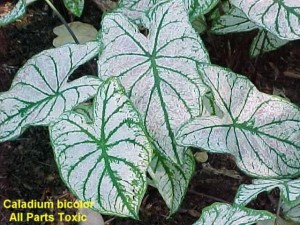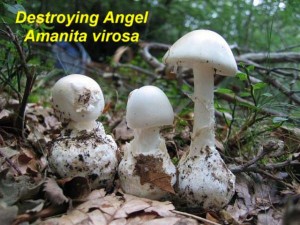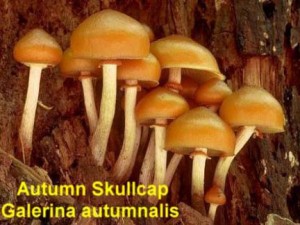La Rochefoucauld said that “To eat is a necessity, but to eat intelligently is an art.” Nearly everybody in his or her life has had at least a small desire to get out of the fast lane and resort back to a simpler way of life. Not the least of these instincts are the pleasure of eating foods provided by nature and becoming, at least for a day, independent of the supermarkets. Edible wild plants and mushrooms grow in our woodlands, marshes, fields, pastures, and in our own landscapes. Some of the best tasting and healthy foods are available “free” for the eating, provided you know which plants and mushrooms are edible!
One of our early cave dwelling ancestors encountered a pretty cluster of mushrooms on the ground and asked:
- What can I do with it?
- Will it feed me?
- Will cure my ills?
An intrepid ancestor ate it and promptly died. Fear of poisonous plants and mushrooms is traceable to stories like this.
The term “POISONOUS” used in this article does not imply that the plants or mushrooms are deadly. Plant and mushroom poisoning can vary from dermatitis to a minor stomach upset, hallucinogenic ‘trips’, or a rather painful, protracted death. There are a number of variables that determine how severe the poisoning symptoms maybe, such as the plant or mushroom species and the person’s age, weight, and health status in relationship to the quantity of the plant or mushroom ingested. Also impacting the severity of the symptoms is the form of plant or mushroom at the time of ingestion (i.e., cooked versus raw, fresh versus aging, etc.).
Don’t be paranoid. Build your knowledge of plants and mushrooms and whether or not they are toxic or edible. Garden centers, nurseries, florists, and Cooperative Extension can assist in plant identification. Plant samples taken in for identification purposes should be fresh and include leaves, stem, flowers, and fruit. For mushrooms, take in the entire fruiting body from cap to base (the part in the ground).
POISONOUS PLANTS
Most of us are familiar with common poisonous plants that cause skin irritation such as Poison Ivy or Poison Oak. More than 100 species of common landscape plants in Georgia, however, can cause illness or death. Many ornamental plants found in the landscape were selected from wild populations due to their foliage, flowers, and scent. In many cases, little or no consideration was given to plant toxicity. Landscape plant toxicity is good in once sense since many herbivores, such as deer and rabbits, and insects, like Japanese beetles, tend to avoid them.
In the vegetable garden, many plants also contain toxins. For example, the stems and leaves of tomatoes, peppers, eggplant, and potatoes (members of the Nightshade family) contain alkaloid toxins that can cause liver damage. The edible fruits of tomatoes, peppers, and eggplants and tubers of potatoes do not contain toxic levels of these alkaloids. Potatoes, however, may turn green in response to light and become toxic. Another member of the Nightshade family, tobacco contains the alkaloid nicotine.
Most adults would not knowingly eat leaves, stems, roots, or fruits from an unknown plant in our pastures, lawns, or forests. This does not apply to our children, livestock, or pets.
Children love plants and love to put things into their mouth just for a taste. Teach them not to eat any plant unless they have permission from a knowledgeable adult and don’t decorate the table with poisonous plants.
Since pets and livestock can’t read, always provide them with plenty of water and palatable feed. Walk the lawn, pasture, and forest to identify potentially poisonous plants. Your local veterinarian can help you learn about local plants that may harm your pets or livestock.
The physiological effects that generally categorize plant poisonings are:
- Abortifacient and Reproductive Toxins: Substances that can cause mutations, birth defects, abortions, and infertility or sterility. Broom snakeweed (Gutierrezia sarothrae) is an example.
- Cardiac Glycoside-Containing Plants: Cardiac glycosides primarily affect cardiovascular, neurological, and gastrointestinal systems and can be found in foxgloves (Digitalis purpurea).
- Cyanide or Prussic Acid-Containing Plants: Prussic acid, cyanide, or hydrocyanic acids are all terms relating to the same toxic substance. It is one of the most rapidly acting toxins. Chokecherry (Prunus spp.) is an example.
- Gastrointestinal Irritants and Toxins: The juice, leaves, roots and seeds of plants containing gastrointestinal irritants can produce stomach cramps, nausea, vomiting, and diarrhea. Examples are aloe, daffodils, and geraniums.
- Alkaloid-Containing Plants: Alkaloid toxicity may result in moderate to severe liver damage. Gastrointestinal symptoms are usually the first sign of intoxication, and consist predominantly of abdominal pain with vomiting. Death may ensue from 2 weeks to more than 2 years after poisoning. Groundsel (Senecio riddellii) is an example.
- Neurotoxic and Myotoxic Plants: All parts of the plant contain toxic steroidal alkaloids that cause cardiovascular failure. An example is Jimson Weed (Datura stramonium).
- Oxalate-Containing Plants: Toxic oxalates form insoluble salts that crystallize and damage vessels and renal tubular epithelium and can be found in Larkspurs (Delphinium spp.).
- Photosensitizing Plants: The poisonous compound in the plant, hypericin, reaches the skin from an internal route (stomach to blood to skin) where it sensitizes the skin to sunlight. Pigments in the skin shield colored skin from sunrays so that only white or unpigmented areas are affected. St. Johnswort is an example.
For a complete listing of Georgia’s poisonous plants including toxic plant parts and symptoms, go to UGA’s Horticultural Fact Sheet “Poisonous Plants in the Landscape” written by Robert Westerfield and Gary Wade at: pubs.caes.uga.edu/caespubs/horticulture/h-00-056.pdf .
| SOME TOXIC ORNAMENTAL PLANTS *Reported to be fatal when ingested in quantity | |||||
| Common Name | Botanical Name | Plant Part | Common Name | Botanical Name | Plant Part |
| Air Potato | Dioscorea bulbifera | Raw fruit | English Ivy | Hedera helix | Leaves, stem, fruit |
| Algerian Ivy* | Hedera canariensis | All parts | Holly | Ilex spp. | Berries |
| Allamanda | Allamanda spp. | All parts | Honeysuckle, Japanese and Trumpet* | Lonicera japonica, Lonicera sempervirens | All parts |
| Amaryllis | Amaryllis spp. | Bulbs & seeds | Hydrangea, Oakleaf Hydrangea, Bigleaf Hydrangea, Smooth | Hydrangea quercifolia, H. macrophylla, H. arborescens | Leaves, bark |
| American Arborvitae* | Thuja occidentalis | Leaves | Impatiens, balsam | Impatiens spp. | Leaves, stem, root |
| Angel’s Trumpet* | Datura spp. | All parts | Iris | Iris spp. | Underground stems |
| Anise-tree* | Illicium floridanum, Illicium anisatum | Leaves | Jack-in-thepulpit | Arisaema spp. | All parts |
| Azalea | Rhododendron spp. | All parts | Juniper | Juniperus spp. | Berry-like seeds |
| Barberry | Berberis spp. | All parts | Lantana* | Lantana spp. | Fruit |
| Black Locust | Robinia pseudoacacia | Bark, seeds | Lily—of-thevalley | Convallaria majalis | All parts |
| Boxwood | Buxus sempervirens | Leaves | Lilies* (Rain Lily, Atamasco Lily, Easter Lily) | Zephyranthus spp. | All parts |
| Buckeye | Aesculus spp. | All parts | Mahonia | Mahonia spp. | All parts |
| Caladium | Caladium bicolor | All parts | Mimosa | Albizzia spp. | All parts |
| Calla-lily | Zantedeschia spp. | All parts | Morning Glory | Ipomoea spp. | Seeds, root |
| Castor Bean | Ricinus communis | Seeds | Mountain Laurel* | Kalmia latifolia | Leaves, twigs, flowers |
| Century Plant | Agave americana | Leaves | Oleander* | Nerium oleander L. | All parts |
| Clematis | Clematis spp. | All parts | Ornamental Tobacco* | Nicotiana spp. | All parts |
| Crinum Lily | Crinum spp. | Bulb | Periwinkle (vine) | Vinca minor | All parts |
| Delphinium* | Delphinium spp. | All parts | Plumbago | Plumbago spp. | Leaves, stem |
| Elephant Ear* | Colocasia esculenta | All parts | Privet | Ligustrum spp. | Fruit |
| False Indigo* | Baptisia spp. | All parts | Sago Palm | Cycas revolute | Seeds, root, trunk pith |
| Firethorn | Pyracantha spp. | Berries | Sweet shrub | Calycanthus floridus | Seeds |
| Four-o-clock | Mirabilis jalapa | Root, seeds | Trumpet Creeper | Campsis radicans | All parts except fruit |
| Ginkgo (female) | Ginkgo biloba | Fruit | Wisteria | Wisteria spp. | Pods, seeds |
| Gloriosa Lily | Gloriosa superba | All parts | Yew* | Taxus spp. | Berries, foliage |
POISONOUS MUSHROOMS
Wild mushrooms are found in all parts of the Georgia landscape: pastures, lawns, forests, and organic mulch of all types. Also on stumps, living trees, and in the home, particularly in basements, plaster board walls, and flower pots. Mushrooms can be found throughout the year, mostly early spring through the fall, if temperature and moisture are suitable for their fruiting.
Mushroom poisoning is caused by the consumption of raw or cooked fruiting bodies (mushrooms or toadstools). The term toadstool is from the German Todesstuhl or Death Stool and is generally applied to poisonous mushrooms. For individuals, who are not expert at mushroom identification, there are no general rules to distinguish between edible mushrooms and poisonous toadstools. Old wives tales notwithstanding, toxic mushrooms cannot be made nontoxic by cooking, canning, freezing, or any other means of processing. The only way to avoid poisoning is to avoid ingesting toxic species.
Mushroom poisonings in the United States commonly occur among:
- Expert and novice wild mushrooms hunters.
- Among recent immigrants that eat wild mushrooms that resemble those of their native land.
- Persons who intentionally consume psychedelic mushrooms.
Accurate figures on the relative frequency of mushroom poisonings are difficult to obtain. The Centers for Disease Control in Atlanta lists 44 cases reported between 1976 and 1981. The number of unreported cases is unknown. Poisonings tend to be grouped in the spring and fall when most mushrooms are in the fruiting stage. As Americans become more adventurous in their mushroom collection and consumption, poisonings are likely to increase.
About 98% of all “wild” mushrooms are not poisonous but about 1% are dangerous (1% are woody or too small to attract any interest). Wild mushrooms should not be eaten unless YOU personally can identify them as safe. Do not rely on the identification any wild mushroom by a neighbor or “expert” amateur mushroom hunter. Remember that “specialists” or “experts” have also been poisoned.
The physiological effects that generally categorize mushroom poisonings are:
- Protoplasmic Poisons: Poisons that result in generalized destruction of cells and with amatoxins results in irreversible liver and kidney damage that is fatal.
- Neurotoxins: Compounds that cause neurological symptoms such as profuse sweating, coma, convulsions, hallucinations, excitement, depression, and spastic colon.
- Gastrointestinal Irritants: Compounds that produce rapid, transient nausea, vomiting, abdominal cramping, and diarrhea.
- Disulfiram-like Toxins: Produce no symptoms unless alcohol is consumed within 72 hours after eating them, in which case a short-lived acute toxic syndrome is produced.
To identify unknown wild mushroom species, I would recommend the Federal Food and Drug Administrations website at www.cfsan.fda.gov/~mow/chap40.html. Since the retirement of Dr. David Porter, UGA’s Plant Pathology Department is ill prepared to identify questionable mushrooms species.
Georgia is home to several species of mushrooms that could cause death if only a single mushroom is eaten. Two such deadly species are the Destroying Angel, Amanita virosa, and the Autumn Skullcap, Galerina autumnalis. Some mushrooms that are not toxic under normal conditions can have a toxic reaction if consumed with alcohol.
|
SOME TOXIC MUSHROOMS *Mushrooms contain protoplasmic toxins
|
|||
|
Common Name
|
Botanical Name
|
Common Name
|
Botanical Name
|
| Slender Death Angel* | Amanita tenuifolia | Autumn Skullcap* | Galerina autumnalis |
| Death Angel* | Amanita bisporigera | Browning Parasol* | Leucoagaricus brunnea |
| Fool’s Mushroom* | Amanita verna | Little Brown Mushroom (LBM)* | Lepiota josserandii, L. helveola, L. subincarnata |
| Destroying Angel* | Amanita virosa | Green Gill | Chlorophyllum molybdites |
| Deathcap (White cap)* | Amanita phalloides | Gray Pinkgill | Entoloma lividum |
| Deathcap (green cap)* | Amanita phalloides | Tigertop Mushroom | Tricholoma pardinum |
| Death cap (Yellow cap)* | Amanita phalloides | Jack O’Lantern | Omphalotus olearius |
| Cleft Foot Deathcap* | Amanita brunnescens | Naked Brimcap | Paxillus involutus |
IN CASE OF A POISON EMERGENCY
In the event of a poison emergency call the Georgia Poison Center any time, 24 hours a day, 7 days a week:
In Metro-Atlanta Call: 404-616-9000
Outside of Metro-Atlanta Call: 1-800-282-5846
Teletype for the deaf and hearing impaired only: TTD 404-616-2987
If the poisoning occurs and the person is having trouble breathing, experiencing seizures, or will not wake up, Call 911 immediately.
Be prepared to give the attending physician:
- The name of plant or mushroom, if known, or description (save uneaten parts).
- How long ago it was eaten.
- How much and which parts were eaten.
- Age of individual.
- Symptoms.
If hospitalization is required, take a portion of the suspect plant or mushroom with you for positive identification




